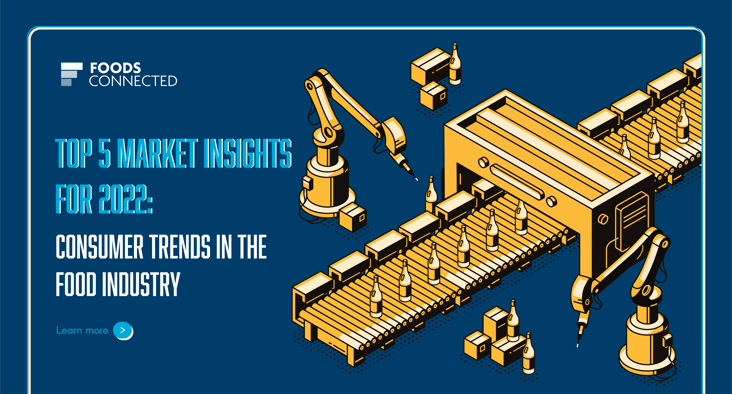
The pandemic has had a dramatic impact on consumers behaviour. Many nations have experienced long and repetitive lockdowns which psychologists claim is more than long enough to form new habits. The challenge for 2022 is to understand which behaviours will remain as we enter the new norm. More than ever it is essential that brands and manufacturers understand what their consumers want and successfully innovate to meet their needs.
Top 5 Insights:
- The Mood for Food
Self-isolation, unemployment and anxiety created by the pandemic has taken it’s toll on mental health across the world. As a result, this has accelerated consumer interest in mental health and prioritised it along with physical health. This holistic approach opens the opportunity for food and drink companies to create products that are nutritious but also have mood or emotional wellbeing enhanced properties. The key areas that are being targeted are stress, sleep and boosting energy. The result of being less stressed, well rested or full of energy also has the positive impact of boosting emotional moods. The trend will continue to include sensory elements of colour, texture and smell that will deliver a more elicit emotional response, where there will be more opportunity to position a product as a mindful choice. Geographically the trend is being interrupted differently to reflect local pressures. Within Europe and the Nordics, consumers are embracing the holistic approach to health and are increasingly focusing on nutritional and specific functional benefits of foods. While in Australia and New Zealand, the trend is more focused on addressing stress and sleep in order to successfully balance work and life.
- Prevention not Cure
The pandemic has shown us how fragile and important health is at both at a personal and public level. It has revealed the importance of physical health especially for those with diet and lifestyle-related health issues who are at higher risk of severe Covid-19 symptoms. As a result, boosting immunity has become a key focus globally. Consumers have become educated on how to boost their immunity through food, vitamins and maintaining gut health. The desire to stay healthy will remain after the pandemic and consumers will continue to see diet and healthy eating as a major part in preventing chronic disease. A new era of nutrition is emerging with food being used as self-care. The opportunity for food and drink companies is to pair products benefits with solutions they provide with clear front of pack messaging to highlight the products benefit. Nutrition will also be used to manage chronic conditions - such as the worlds most popular diet, Keto, which was originally created to manage epilepsy. The trend will evolve further to promote smart nutrition and develop calorie-controlled foods with a complete nutritional profile. While traditionally these meal replacement products have been in the form of drinks and positioned as weight loss products, there is an opportunity to extend into fresh formats with more holistic health claims.
- Preserve my Health
The use of food preservatives ensures food safety by preventing spoilage due to microbiological, physical, chemical or enzyme reactions. There are a wide variety of artificial preservatives in the market, but there has been an increase in awareness amongst consumers of the negative impact these can have on health. Consumers also perceive artificial preservatives as reducing the nutritional content of products. This taps into the clean label trend that gives food and drink companies the opportunity to create premium products with no preservatives or natural preservatives. There is a growth in manufacturers and scientists exploring new processes and packaging technologies that will not require the addition of preservatives, without spoiling the organoleptic qualities of a product. North America is leading the way with the highest number of new product launches carrying a no or natural preservative claims, with snacks, bakery and processed protein being the leading categories. Hero ingredients, those that have more than one function in a products formulation, are also emerging into the preservative space. Innovators are exploring the role of ingredients that can enhance the flavour or provide health benefits, while also extending shelf life.
- Planet Time
As more markets aim to recover from the disruptions of the pandemic, food and drink companies will need to revisit pre-pandemic sustainable, ethical and social priorities. The pandemic has served as a stark reminder of how intrinsically linked our planet and our personal health are, with many consumers now associating a healthier diet as being healthier for the planet. The pandemic has also brought communities together and consumers will be looking for brands and retailers to make more responsible commitments to echo their new-found community spirt and protection of the planet. The focus on our environment will become the single biggest disruptive factor in the choice’s consumers make in their diet and behaviours. Sustainable nutrition is becoming an important topic as governments layout personal and planet diet guidelines and the introduction of eco-scores and on-pack sustainability labelling will allow consumers to become aware and considered in the food choices they make. Sustainable nutritional can carry many claims but also often carry premium prices, so the opportunity for food and drink companies is to make it affordable. Innovation is no longer just about product formulation but about values and being leaders in ESG. The opportunity is for companies to be active and transparent about their initiatives in order to retain and attract new customers. In the UK and Ireland consumers are prioritising local and looking for companies to support local communities while in Europe consumers are focusing more on reducing their carbon footprint. While carbon emissions and air pollution are the major focus in Australia and New Zealand with renewable energy and carbon neutrality being the key goals. Sustainable innovation should also consider the implications of its packaging as consumers will return their attention back to reducing plastic use once a stable recovery phase happens.
- Evolution of Value
The pandemic and its economic repercussions have made value a primary motivator for consumers. The quest for value is not just about price, it is multifaceted to include taste, quality, health, convenience and safety. The demand for 'better basics' is emerging and there is an opportunity for frozen and ambient suppliers to promote the benefits of their products against fresh and more expensive alternatives. The pandemic has also shone a light on the importance of food safety and there is an opportunity for food and drink companies to promote safety measures from farm to fork. Safety endorsements are starting to be connected to quality, making them more valuable to consumers and ‘natural’, ‘organic’ and other claims about ‘less processed’ foods are becoming more popular. Many consumers will continue to spend more time at home during 2022, creating an innovation opportunity for budget friendly, time saving creative solutions whether that is an indulgent small treat or an affordable luxury. Food and drink companies should not overlook developing premium products, as despite tight budgets, in-home solutions are cheaper than those out of the home. Value is diversifying, but quality and taste will always be the secret to any products success.

Grace Shearer
Grace Shearer works for Hilton Food Group as Group Insight Senior Manager and has been providing insight and category development initiatives within the FMCG sector for over 20 years. She has over 15 years’ experience in within the meat industry influencing retailer and supplier strategy to align with consumer trends. Within Hilton Food Group, Grace is responsible to find, interrogate and interpret data sources to deliver a consumer centric culture which influences strategy, enhances new business opportunities and strengthen local insight to drive business volume, turnover and profit.
Stay up to date
Stay up to date
Browse Posts
- December 2025
- November 2025
- October 2025
- September 2025
- August 2025
- July 2025
- June 2025
- May 2025
- April 2025
- March 2025
- February 2025
- January 2025
- December 2024
- November 2024
- October 2024
- September 2024
- August 2024
- July 2024
- June 2024
- May 2024
- April 2024
- March 2024
- February 2024
- January 2024
- December 2023
- November 2023
- October 2023
- September 2023
- August 2023
- July 2023
- June 2023
- May 2023
- April 2023
- March 2023
- December 2022
- November 2022
- October 2022
- September 2022
- August 2022
- July 2022
- June 2022
- May 2022
- April 2022
- March 2022
- February 2022
- January 2022
- December 2021
- November 2021
- October 2021
- August 2021
.png)

/Blog%20Headers/shutterstock_1927957907%20(1).jpg)
/Blog%20Headers/shutterstock_1845178195%20(2).jpg)
/Blog%20Headers/shutterstock_2133827717%20(1).jpg)
/Blog%20Headers/shutterstock_2473376713.jpg)
/Blog%20Headers/shutterstock_2247276303.jpg)
.png)
.png)



/Blog%20Headers/James%20Hennessy%20(1)%20(3).png)
/Blog%20Headers/shutterstock_1313461523.jpg)
.png)
.png)
/1.%20HubSpot%20Images/AdobeStock_444686342.jpeg)
/Blog%20Headers/NPD_screen%20and%20test-1.jpg)
/Graphics%20used%20in%20blogs/temple%20grandin%20visit%202024%2006.jpg)
/Blog%20Headers/Why%20Forward%20Traceability%20Is%20Essential%20for%20Food%20Supply%20Chain%20Transparency%20and%20Compliance.jpg)
/Blog%20Headers/Captain%20Ds%20-%20Overhead%20-%20Variety.jpg)
.png)